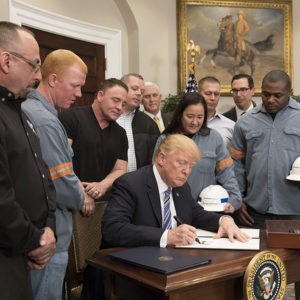With an unemployment rate of just 3.8 percent and first-quarter economic growth of 2.8 percent, the U.S. economy looks good. But as President Trump continues to impose unpredictable protectionist trade policies on more goods and more countries, expect the economy to lose some of its steam.
In short, the president needs to rethink his trade policy. Here’s why:
Tariffs on specific goods help domestic producers of those goods, but hurt a country’s overall economy. This, and the uncertainty over the administration’s future trade policy, will surely dampen overall investment and trade. We should also expect retaliation from our trading partners to make things worse.
More than half of U.S. imports are “intermediate goods” like steel, which are used to produce “final goods” like cars. That means that a steel tariff raises the cost of producing a car, and ultimately car prices. You could say the same for lumber and houses, fabric and clothes, and countless other products we all rely on.
As costs rise, Americans purchase less. Companies start producing less and employ fewer people. As buyers switch to more expensive (and sometimes less-efficient) domestic producers, overall productivity growth takes a hit. None of this is good for long-term economic growth.
Recent research by economists shows that increasing a tariff sends a negative shock through the economy, depressing output and raising prices, much like higher oil prices have done in the past. Economists Fernando Leibovici and Jonas Crews, for example, found that increasing tariffs by 5 percent decreases GDP per worker by 2 percentage points within two years.
Policy uncertainty creates a set of economic problems all its own. This happens when on-and-off again tariff threats have no clear rationale as to which countries are to be dinged or by how much. Expect this policy uncertainty to have a negative effect on companies’ decisions to invest or hire — especially when it comes to cross-border investment. After all, it’s very difficult to make financial commitments when you don’t know what the system will look like months or years from now.
My own research finds that an increase in economic policy uncertainty reduces foreign direct investment into the United States by an average of about 5 percent for the following three years. Policy uncertainty also increases investment volatility — creating even more uncertainty — and reduces imports and exports.
Things can get worse. U.S. trading partners will not stand idly by as we raise tariffs on steel, aluminum and cars. They will respond in kind by raising their own tariffs on the products we sell to them. And they will choose major U.S. exports produced in battleground states to force the president to think about the effect of his trade policies on his re-election chances. This is exactly what happened to President Bush when he tried to protect the steel industry with tariffs in 2002 and 2003.
We can expect the World Trade Organization to get dragged into this mess. It was designed to expand international commerce and to establish fair international trading rules for all members to follow. Because the administration’s national security justification for the newly imposed tariffs is considered weak, most will be challenged as countries appeal to the WTO.
We should prepare for the likelihood that the WTO rules against the United States, forcing us to remove the tariffs or face economic sanctions. Given that choice, most countries comply to avoid inflicting more damage on the economy.
Or President Trump could change his trade policy now. If his administration disagrees with our trading partners over the legitimacy of specific trade policies, they can turn to the WTO for an effective resolution of these disputes.
Despite the president’s claims to the contrary, no one wins a trade war.

